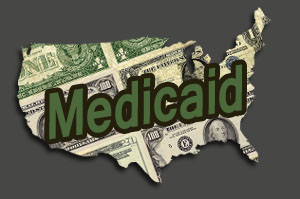Correction: This story has been updated to note that the District of Columbia in 2015 is not extending the Medicaid pay increase for physicians. The story originally listed D.C. with the six states that are keeping doctor pay higher next year. The District will allow Medicaid pay rates to fall back to earlier levels.
Just six states will use their own money in 2015 to sustain the federal Medicaid pay raise to primary care doctors, which was a key provision of the Affordable Care Act intended to make sure millions of low-income people enrolling in the expanding insurance program have access to a physician.
Interestingly, two of the states extending the pay raise are Alabama and Mississippi — neither of which expanded Medicaid under the health law. The other states extending the pay raise next year are Colorado, New Mexico, Iowa and Maryland, according to interviews with state officials and the American Medical Association. Those four states expanded their Medicaid eligibility to cover everyone with incomes less than 138 percent of the federal poverty level, or about $15,900 for an individual.
Alaska and North Dakota paid primary care doctors in Medicaid the higher rates even before the health law’s provision took effect in 2013.
The other 42 states and the District of Columbia will let the Medicaid pay rates revert back to their 2012 levels.
Under the law, Medicaid fees for primary care increased in 2013 and 2014 to the same amount paid under Medicare. While Medicaid fees vary by state, the change meant an average 73 percent pay increase nationally, according to a 2012 study by the Kaiser Family Foundation and the Urban Institute. (Kaiser Health News is an editorially independent program of the foundation.)
Nationally, it’s unclear whether the higher fees attracted more doctors into Medicaid or made doctors more willing to treat more Medicaid patients. The Obama administration is not collecting any data to show the impact of the higher fees, said a spokeswoman for the Centers for Medicare & Medicaid Services. State Medicaid officials also have not studied the impact.
For years, some states have struggled to attract doctors to Medicaid, largely because of their low pay. About 69 percent of doctors nationally accept new Medicaid patients, but the rate varies widely across the country, according to a study published in 2012 in the journal Health Affairs. New Jersey had the nation’s lowest rate at 40 percent, while Wyoming had the highest, at 99 percent, according to a survey of doctors by the U.S. Centers for Disease Control and Prevention.
Physician groups, while pleased with the extra funding, have said for years that the two-year cap would limit its impact on persuading more doctors to treat Medicaid patients. Still, they worry about what happens when the short-lived pay raise goes away in most states.
“Yes, the money has made a difference,” said James Perrin, president of the American Academy of Pediatrics. “Anecdotally we are hearing about more doctors seeing more Medicaid patients and using extra money to add staff.”
The academy was hoping Congress would extend federal funding because it is difficult for most states to come up with extra money. But there’s no sign a divided Congress will do that.
The health law pay raise was slated to cost the federal government $11 billion, according to the Congressional Budget Office.
The Florida Medical Association this week came out in favor of the state expanding Medicaid, but only if the state comes up with $451 million to extend the primary care pay raise. The extension would maintain the 50 percent increase in pay to Florida’s primary care doctors.
The Mississippi State Medical Association, which represents physicians, said legislative support was strong for expanding the pay hike even despite opposition to Obamacare among state leaders. “Even though the money was tied to Obamacare, it did help out the state because of the need to help primary care physicians,” said Blake Bell, a lobbyist for the association. He said the state estimates the annual cost to continuing the 10 percent pay raise to primary doctors to be about $12 million.
“This does help to incentivize our physicians to continue taking Medicaid patients because these are uncertain waters for physicians right now,” Bell said.
In Alabama, 90 percent of all Medicaid reimbursements go to only 22 percent of the state’s primary care physicians. In lobbying for the continued pay rates, the Alabama Medical Association focused on how the state will need more primary care physicians participating in the program, said Mark Jackson, the association’s executive director. “It’s been our goal for a while to get those rates up … and this wasn’t discussed as being part of Obamacare but rather in terms of getting people better access to care.”
The legislature this year approved $32 million in funding to extend the nearly 30 percent pay raise to its primary care doctors in 2015. It was the first across the board pay raise to primary care physicians in nearly 20 years. More than 3,000 physicians will benefit.
“It was a simple decision,” said Don Williamson, Alabama’s state health officer who oversees Medicaid. “If we let those higher rates expire, our primary care would unravel and this money would keep things in place.”
Joan Alker, executive director for the Georgetown University Center for Children and Families, said she was surprised some states that did not expand Medicaid were extending the pay raise. “It suggests that states like Alabama and Mississippi recognize Medicaid’s importance in their health care systems despite their refusal so far to expand coverage to those falling into the coverage gap,” she said.
This blog post was updated to note that the 2012 study on Medicaid pay rates was produced by the Kaiser Family Foundation and the Urban Institute.







